Northern Lights M1064A, M1064D, M1064T1, M1064T2, M1066A1 Operator's Manual
...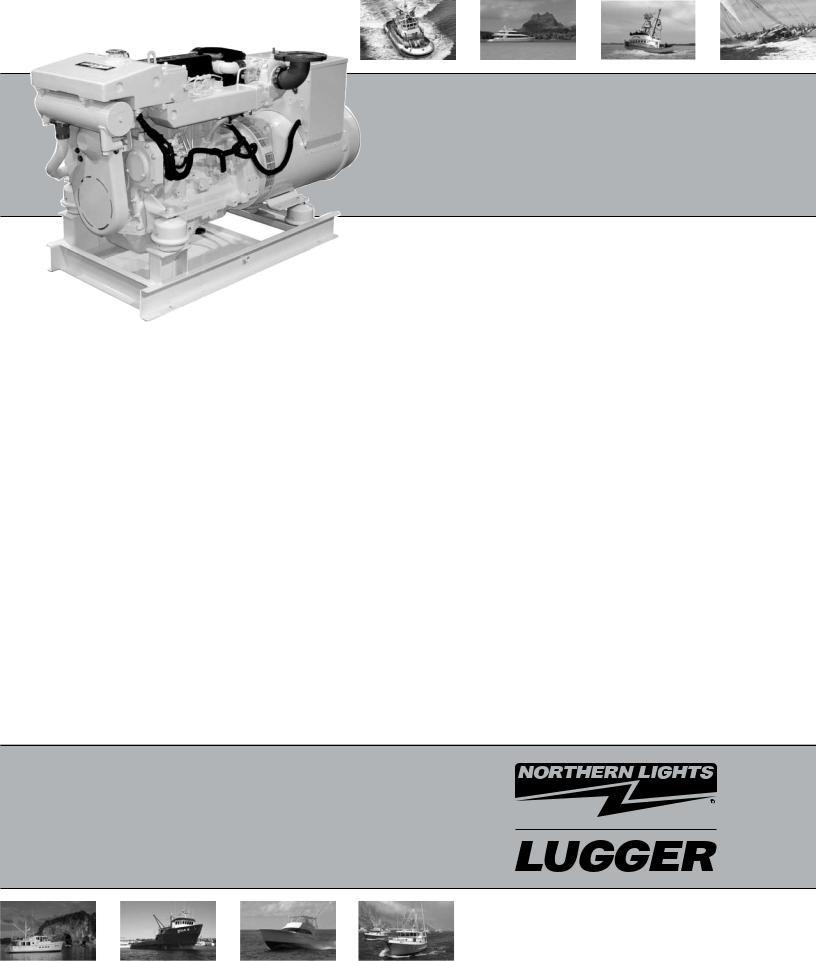
OM2-2
For Models: M1064A, M1064D, M1064T1, M1064T2,
M1066A1, M1066A2, M1066A3, M1066T, M40C2,
M55C2, M65C2, and M99C2
OPERATOR’S MANUAL
Marine Generators | Marine Diesel Engines | Land-Based Generators
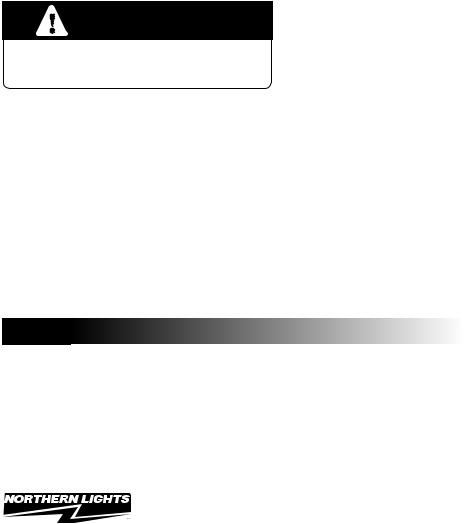
— CALIFORNIA —
Proposition 65 Warning:
Diesel engine exhaust and some of its constituents are known to the State of California to cause cancer, birth defects, and other reproductive harm.
Northern Lights
4420 14th Avenue N.W.
Seattle, WA 98107
Tel: (206) 789-3880
Fax: (206) 782-5455
Copyright ©2008 Alaska Diesel Electric, Inc. All rights reserved. Northern Lights™, and the Northern Lights logo are trademarks of Alaska Diesel Electric, Inc.
Printed in U.S.A.
PART NO.: OM2-2 11/08
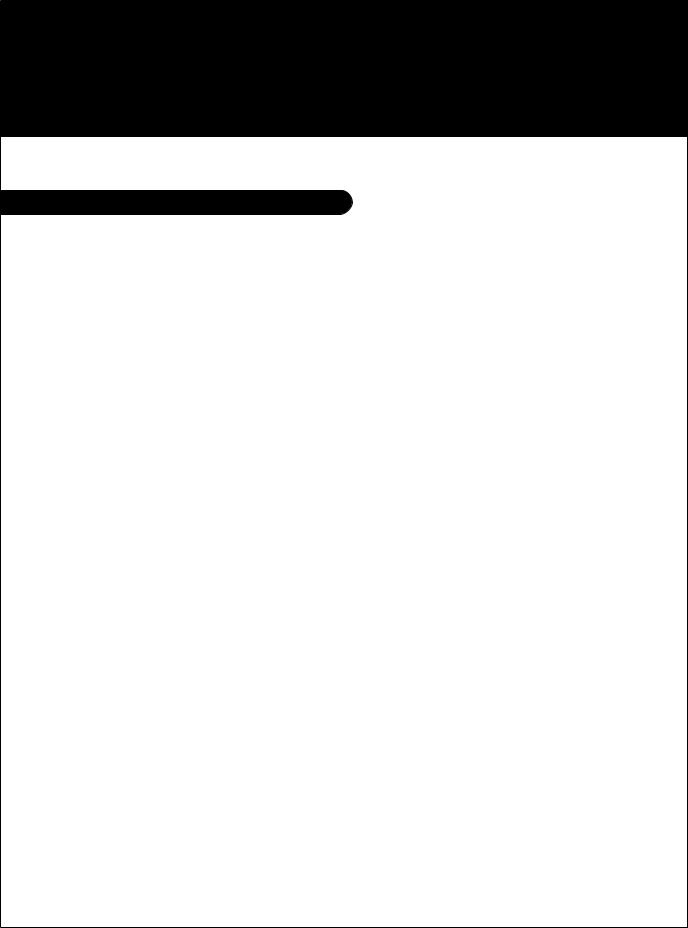
OPERATOR'S MANUAL
#OM2-2 for Models:
M1064A, M1064D, M1064T1, M1064T2, M1066A1, M1066A2, M1066A3, M1066T, M40C2, M55C2, M65C2, and M99C2
Read this operator's manual thoroughly before starting to operate your equipment. This manual contains information you will need to run and service your new unit.
Table of Contents |
|
Introduction ..................................................... |
4 |
Models Included.................................................. |
4 |
Model Numbers................................................... |
4 |
Serial Numbers.................................................... |
4 |
Warranty............................................................. |
5 |
Safety Rules...................................................... |
5 |
Component Locations |
|
M1064.................................................................. |
6 |
M1066.................................................................. |
7 |
M40C2................................................................. |
8 |
ENGINE & GENERATOR CONTROL Panels |
|
Series 3B & 4B.......................................... |
10 - 11 |
Operating Procedures |
|
Before Starting.................................................. |
12 |
Shutdown Procedures....................................... |
12 |
Break-In Period................................................. |
13 |
Servicing Schedule ChartS........... |
14 - 15 |
Servicing |
|
Lubrication - General........................................ |
17 |
Checking Oil..................................................... |
17 |
Oil Changes...................................................... |
17 |
Changing Oil Filter........................................... |
17 |
Air Filter........................................................... |
17 |
Valve Clearances............................................... |
18 |
Fuels - General.................................................. |
19 |
Crankshaft Vibration Damper (6 Cyl.)............. |
19 |
Fuel Filters................................................ |
19 - 20 |
Bleeding the Fuel System................................. |
20 |
Injector Service......................................... |
20 - 22 |
Injection Pump.......................................... |
22 - 24 |
Turbocharger..................................................... |
25 |
Turbo Boost...................................................... |
25 |
Cooling System - General................................. |
25 |
Engine Coolant Specifications.................. |
25 - 26 |
Cooling System Flushing.................................. |
27 |
Heat Exchanger Cleaning................................. |
27 |
Zinc Electrodes......................................... |
27 - 28 |
Raw Water Pump.............................................. |
28 |
Generator Ends................................................. |
28 |
Electrical System - General.............................. |
28 |
Booster Batteries............................................... |
29 |
Battery Care...................................................... |
29 |
Winterizing / Out-of-Service............................ |
29 |
Troubleshooting |
|
Electrical........................................................... |
30 |
Engine....................................................... |
31 - 32 |
Wiring Diagrams |
|
AC Wiring................................................. |
33 - 34 |
DC Wiring................................................. |
35 - 52 |
ON-BOARD SPARE PARTS............................... |
53 |
Proprietary Information
This publication is the property of Alaska Diesel Electric, Inc.
It may not be reproduced in whole or in part without the written permission of Alaska Diesel Electric, Inc. © Alaska Diesel Electric, Inc. All rights reserved. Litho U.S.A. Publication number OM2-2 11/08
OM2-2 11/08
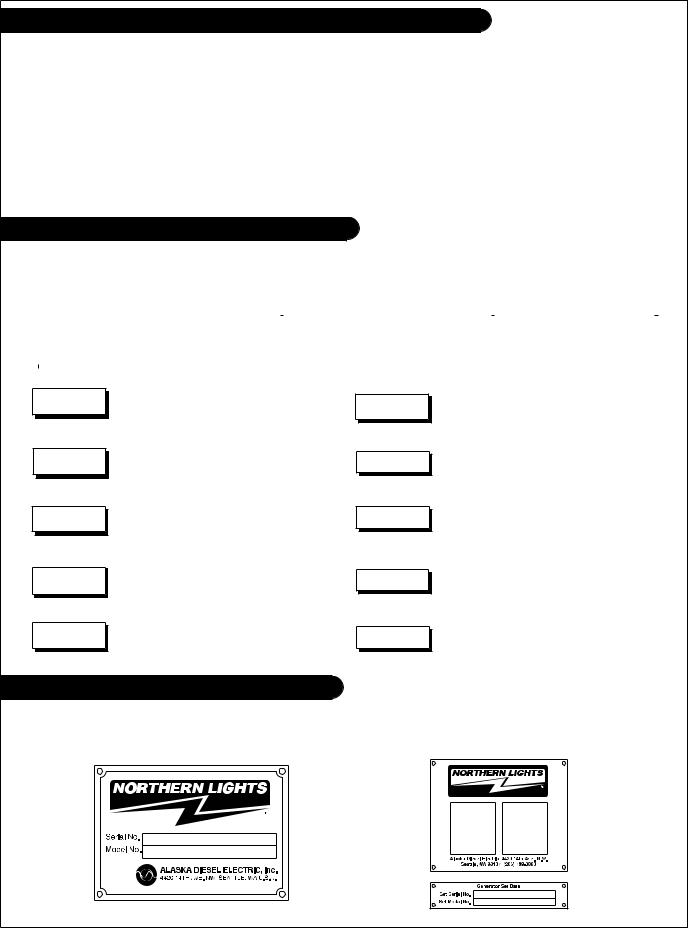
Introduction
Servicing of marine engines and generator sets presents unique problems. In many cases boats cannot be moved to a repair facility. Marine engines cannot be compared to the servicing of automobiles, trucks or even farm equipment. Failures often occur in remote areas far from competent assistance. Marine engines are taxed far more severely than auto or truck engines; therefore, maintenance schedules must be adhered to more strictly.
Failures begin with minor problems that are overlooked and become amplified when not corrected during routine maintenance.
As operator, it is your obligation to learn about your equipment and its proper maintenance. This is not a comprehensive technical service manual. Nor will it make the reader into an expert mechanic. Its aim is to aid you in maintaining your unit properly.
Model Numbers
Model numbers give the unit's application, block model, aspiration, and RPM:
|
|
M |
|
|
1064 or 1066 |
|
|
|
A, D, & T |
|||||||
|
|
|
|
|
|
|
|
|
|
|
|
|
|
|
|
|
|
|
|
|
|
|
|
Model number |
|
|
A - Aftercooled |
||||||
|
M - Northern Lights marine generator set |
+ |
|
106 mm bore, 4 Cylinder |
+ |
|
||||||||||
|
|
|
D - Naturally aspirated |
|||||||||||||
|
|
|
|
|
|
|
|
or |
|
|
T - Turbocharged |
|||||
|
|
|
|
|
|
|
106 mm bore, 6 Cylinder |
|
|
|||||||
|
|
|
|
|
|
|
|
|
|
|
|
|
||||
|
|
|
|
|
|
|
|
|
|
|
|
|
|
|
|
|
M1064A
M1064D
M1064T1
M1064T2
M1066A1
=Northern Lights® aftercooled, 1800 RPM marine diesel generator set with a John Deere Powertech Tier II 4045 engine block with an electronically controlled fuel system.
Northern Lights® naturally aspirated, 1800
=RPM marine diesel generator set with a John Deere Powertech Tier II 4045 engine block with a mechanically controlled fuel system.
Northern Lights® turbocharged marine
=generator set with a John Deere Powertech
Tier II 4045 engine block with a mechanically controlled fuel system.
Northern Lights® turbocharged marine
=generator set with a John Deere Powertech
Tier II 4045 engine block with an electronically controlled fuel system.
Northern Lights® aftercooled marine generator
=set with a John Deere Powertech Tier II 6068 series 1 engine block with an electronically controlled fuel system.
M1066T
MP40C2
MP55C2
MP65C2
MP99C2
Northern Lights® turbocharged marine
=generator set with a John Deere Powertech Tier II 6068 engine block with an electronically controlled fuel system.
40 kW Northern Lights® commercial marine
=generator set with a John Deere Powertech Tier II 4045 engine block with a mechanically controlled fuel system.
=55 kW Northern Lights® commercial marine generator set with a John Deere Powertech Tier II 4045 engine block and a mechanically controlled fuel system.
65 kW Northern Lights® commercial marine
=generator set with a John Deere Powertech Tier II 6068 engine block and an electronically controlled fuel system.
=99 kW Northern Lights® commercial marine generator with a John Deere Powertech Tier
II 6068 engine block and an electronically controlled fuel system.
Serial Numbers
When referencing Alaska Diesel Electric equipment by serial number, please refer only to the number stamped on the Northern Lights® serial number plate.
OM2-2 11/08
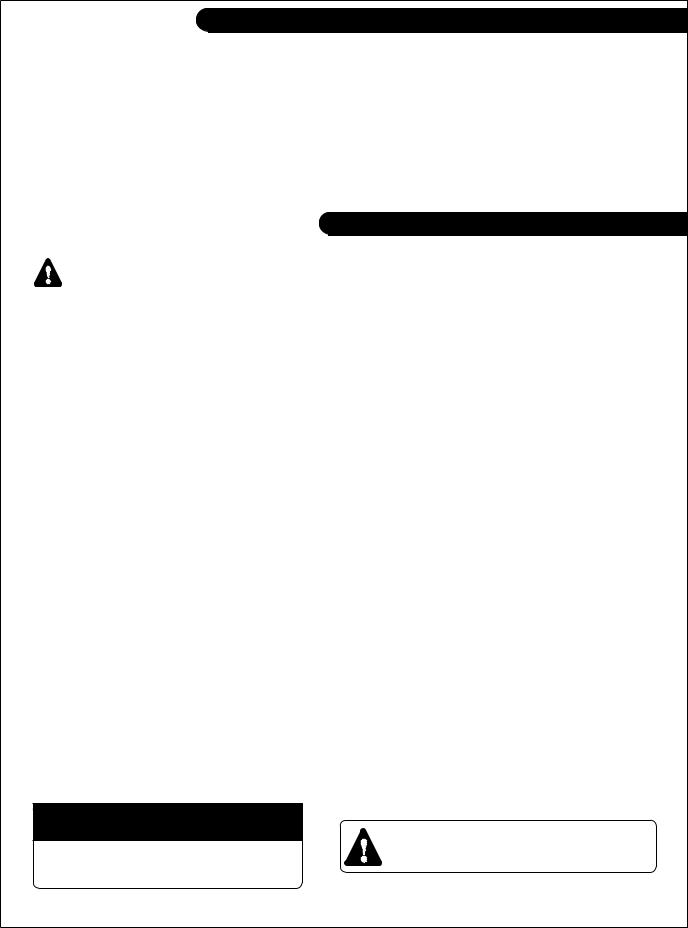
Warranty
A warranty registration certificate is supplied with your set. The extent of coverage is described in the Limited Warranty Statement. We recommend that you study the statement carefully.
NOTE: If the warranty is to apply, the servicing instructions outlined in this manual must be followed. If further information is needed, please contact an authorized dealer or the factory.
Safety Rules
CAUTION: Accident reports show that careless use of engines causes a high percentage of accidents.
You can avoid accidents by observing these safety rules. Study these rules carefully and enforce them on the job.
•Never leave engine without proper security.
•Turn the coolant tank cap slowly to relieve pressure before removing. Add coolant only when the engine is stopped and cool.
•Mount a fire extinguisher near engine.
•Always disconnect the battery ground strap before making adjustments.
•Operate engines in properly ventilated areas.
•Keep trash and other objects away from engine.
•Escaping fluids under pressure can penetrate your skin. Use a piece of cardboard or wood, not your hands, to search for leaks.
•Avoid wearing loose clothing when working around engines.
•Do not oil or grease engine while it is running.
•Always disconnect the ECU (Electronic Control Unit) connectors and remove the ground connection for the engine control system-to- machine frame before welding on engine. Make sure no other electronic components are in the ground path also.
•Use caution in handling fuel. Never refuel a hot or running engine. Do not smoke while filling fuel tank or servicing fuel system.
•Keep your hands, feet, hair and clothing away from power-driven parts.
•Check for any loose electrical connections or faulty wiring.
•Engines should be operated only by knowledgeable, qualified personnel.
•Look completely around engine to make sure that everything is clear before starting.
•Do not operate an engine that isn't in proper working order. If an unsafe operating condition is noted, tag the set and control panel so others will also know about the problem.
•Provide first aid kits.
CALIFORNIA
Proposition 65 Warning:
Diesel engine exhaust and some of its constituents are known to the State of California to cause cancer, birth defects, and other reproductive harm.
CAUTION: This symbol is used throughout this book to alert you to possible danger areas. Please take special notice of these sections.
OM2-2 11/08
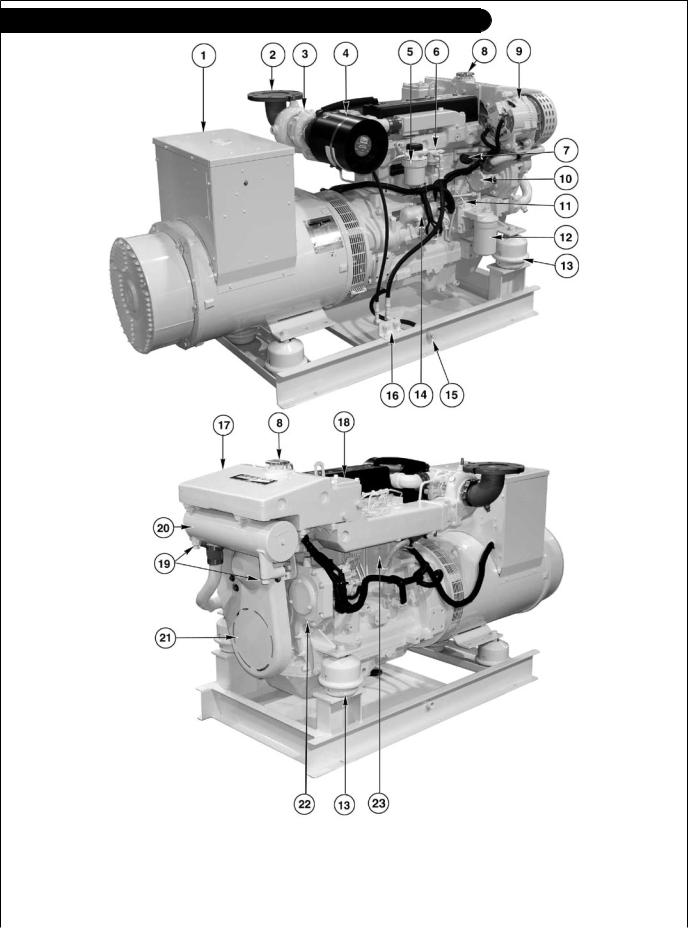
Component Locations
Figures 1 & 2: M1064T1
(Mechanically Controlled Fuel System)
1. |
Junction Box |
8. |
Coolant Fill |
15. |
Lube Oil Drain |
22. Injection Pump Drive |
2. |
Exhaust Elbow |
9. |
Alternator |
16. Fuel Manifold |
Coupling Access Cover |
|
3. |
Turbocharger |
10. |
Raw Water Pump |
17. Expansion Tank |
Plate |
|
4. |
Air Cleaner |
11. |
Lube Oil Dipstick |
18. Thermostat Cover |
23. Engine Block Drain |
|
5. |
Fuel Filter |
12. |
Lube Oil Filter |
19. |
Heat Exchanger Zincs |
|
6. |
Fuel Lift Pump |
13. |
Optional Hydrolastic Mount |
20. Heat Exchanger |
|
|
7. |
Lube Oil Fill |
14. Starter |
21. Belt Guard |
|
||
|
|
|
|
|
||
|
|
|
OM2-2 11/08 |
|
||

Component Locations
Figure 3 & 4: M1066T (Mechanically Controlled Fuel System)
1. |
Coolant Fill |
9. |
Air Cleaner |
17. Heat Exchanger Zinc (2) |
24. Optional Governor Actuator |
2. |
Expansion Tank |
10. |
DC Circuit Breaker |
18. Heat Exchanger Drain |
25. Drive Belt Cover |
3. |
DC Alternator |
11. |
Turbocharger |
19. Heat Exchanger |
26. Fuel Manifold |
4. |
Lube Oil Fill |
12. |
Wet Exhaust Elbow |
20. Raw Water Pump |
27. A.V.R. Fuse |
5. |
Lube Oil Filter |
13. |
Exhaust Manifold Drain |
21. Fuel Injectors (6) |
28. Fuel Filter |
6. |
Fuel Lift Pump |
14. |
Electric Starter |
22. Thermostat cover |
|
7. |
Lube Oil Dipstick |
15. |
Engine Block Drain |
23. Optional Hydrolastic |
|
8. |
Lube Oil Drain |
16. |
Fuel Injection Pump |
Mounts |
|
|
|
|
|
|
|
|
|
|
|
OM2-2 11/08 |
|
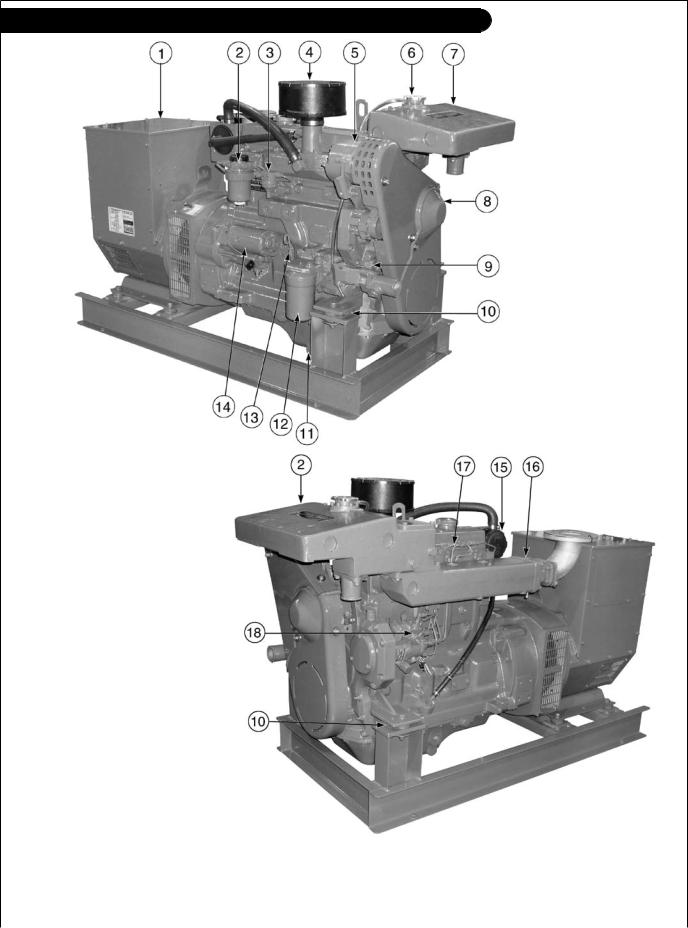
Component Locations
Figure 5 & 6: M40C2 (Mechanically Controlled Fuel System)
1. |
Junction Box |
6. |
Coolant Fill |
11. Lube Oil Drain |
16. Exhaust Manifold |
2. |
Fuel Filter |
7. |
Expansion Tank |
12. Lube Oil Filter |
17. Injection Lines |
3. |
Fuel Lift Pump |
8. |
Belt Guard |
13. Dipstick |
18. Fuel Injection Pump |
4. |
Air Cleaner |
9. |
Coolant Pump |
14. Electric Starter |
|
5. |
Alternator |
10. Centerbonded Mounts |
15. Closed Crankcase Vent |
|
|
|
|
|
|
|
|
|
|
|
|
OM2-2 11/08 |
|

Notes
OM2-2 11/08

Northern Lights Control Panels
1. shutdown bypass switch
This switch bypasses the safety shutdown feature during the starting process.
2. engine control switch
To start the engine, hold this switch in the START position until the engine is running.
NOTE: Excessive cranking of marine sets equipped with water lift muffler systems can cause engine damage.
After the engine starts, release the switch and it will return to RUN position. To stop the engine, hold the switch in the STOP position.
3. oil pressure gauge
The oil pressure gauge shows the oil pressure in the engine lubricating system. If the pressure drops
Figure 7: Series 3B Generator Control Panel below 15 PSI at a speed higher than idling, stop the engine and investigate.
4. coolant temperature gauge
Water temperature gauge shows the temperature of the cooling water. If the gauge registers over 200°F (93.30C) or drops below 140°F (600C), stop the engine and investigate.
5. hour meter
Keeps track of the engine running time.
6. dc voltmeter
When the engine is running, it indicates the voltage output of the alternator.
OM2-2 11/08
10
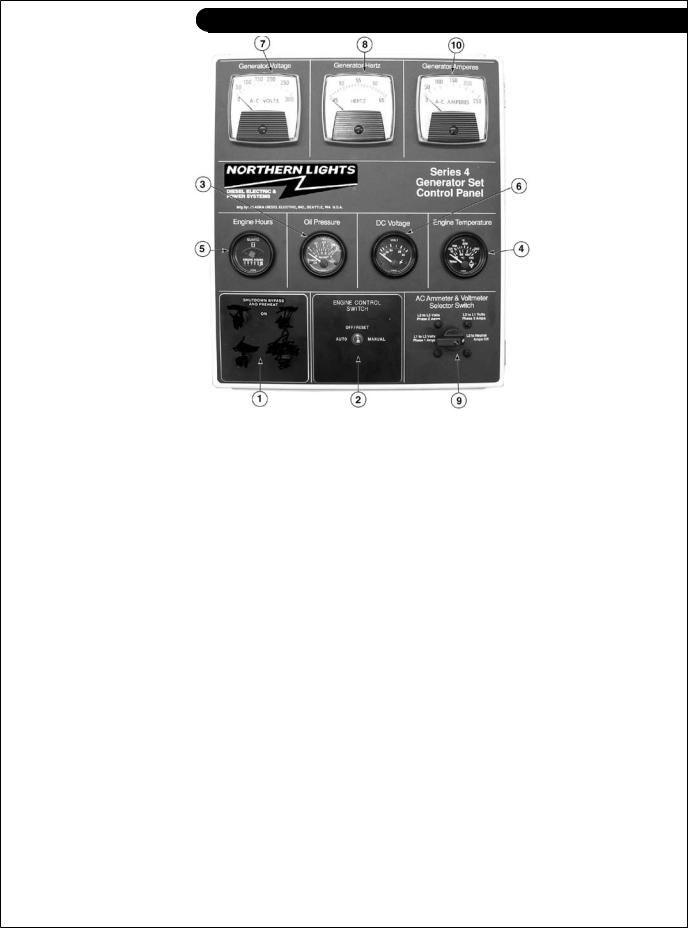
Northern Lights Control Panel
Figure 8: Series 4 B Generator Control Panel
1.shutdown bypass switch
This switch bypasses the safety shutdown feature during the starting process.
2.engine control switch
The control switch starts and stops the engine.
3.oil pressure gauge
The oil pressure gauge shows the oil pressure in the engine lubricating system. If the pressure drops below 15 PSI at a speed higher than idling, stop the engine and investigate.
4.coolant temperature gauge
Water temperature gauge shows the temperature of the cooling water. If the gauge registers over 200° (93.30C) or drops below 140°(600C), stop the engine and investigate.
5.hour meter
Keeps track of the engine running time.
6.dc voltmeter
When the engine is running, it indicates the voltage output of the alternator.
7.ac voltmeter
The voltmeter shows the generator output voltage, phase to phase. If the voltage fluctuates greatly from the normal reading, shut down the unit and investigate.
8.frequency meter
Indicates engine speed. The correct reading for 1800 and 1200 RPM sets is 60 Hz. For 1500 RPM sets, it is 50 Hz. If meter does not indicate correct hertz, stop and investigate.
9.ammeter selector switch
The ammeter switch is used for checking each phase for load condition. Leave it in the ON position while the engine is running.
10.ac ammeter
The ammeter indicates the phase load. Check for load unbalance. If the unbalance is greater than 30%, have an electrician balance the load properly. This will ensure longer generator life and better economy.
OM2-2 11/08
11

Operating Procedures
Before Starting
1.Check the water level by removing the pressure cap from the expansion tank. In order to give the cooling water room to expand, the level should be about 1 3/4 in. (4-5 cm) below the filler cap sealing surface when the engine is cold. When filling with coolant, the venting cock on top of the turbocharger
should be opened to ensure that no air pockets form in the cooling system (see Service Point #14).
CAUTION: Use protective clothing and open  the filler cap carefully when the engine is warm to prevent burns.
the filler cap carefully when the engine is warm to prevent burns.
2.Check the oil level in the crankcase with the dipstick.
The oil level should be between the “waffled area” and the “oo”. Never allow the level to go below the “oo”. Always add the same viscosity of oil as is already in the crankcase (see Service Point #1).
3.Check the fuel tank level and open any fuel valves.
4.Disengage clutch, if equipped.
5.Close the seacock, check and clean the strainer and reopen the seacock.
6.Place the battery switch in the ON position.
NOTE: The battery switch must always be kept ON while the engine is running. If the switch is turned OFF while the engine is running, the battery charging regulator could be ruined.
Starting
1.While holding the Shutdown Bypass switch in the ON position, push the Engine Control switch to the START position.
2.As soon as the engine starts, release both switches. Do not crank the starter for more than 20 seconds.
3.If the engine fails to start the first time, be sure the starter has stopped before re-engaging.
NOTE: If there is a governor locked at a specific speed on the generator set, there may not be a slow idle function, so in that case operate the engine at high idle for 1 to 2 minutes before adding load. If the stand-by generator set is loaded as soon as it reaches rated speed, this procedure would not apply.
Operating
1.Check Gauges Often: Oil pressure must be above 29 PSI (if not above 15 PSI within 5 seconds of starting, the engine should be stopped and the problem should be explored). Normal oil pressure is 50 PSI at rated load speed (1800 to 2500 RPM). Oil temperature should be 1150C (2400F) for normal operating temperature. The D.C. voltmeter should read between 13 and 14 volts (26-28 volts, 24 volt systems).
2.Check AC voltage and frequency meters (Series 4 Panel). If gauges deviate from normal levels, shut down the set and investigate.
3.Check belt for good alignment.
4.Let the unit run unloaded for a three to five minute warm-up period before applying load.
5.Do not add full electrical load until engine is at maximum operating temperature.
Shutdown
1.Turn the Engine Control Switch to the OFF position.
2.Close the sea cock and fuel valves, and put the battery switch in the OFF position if the unit will be off for an extended period.
NOTE: Do not turn the battery switch to OFF while the engine is running.
Shutdowns and Alarms
1.Your unit is fitted with a system to protect it from high water temperature or low oil pressure.
a.Generator sets have shutdown systems to stop the engine. They have no warning horns.
b.Other alarms and shutdowns are available as optional equipment.
NOTE: Do not rely on your warning or shutdown system to the exclusion of careful gauge monitoring. Watching your gauges can prevent damage to the unit and dangerous power losses.
2.Do the following when your shutdown system is activated:
a.Check the temperature gauge. If the temperature is above 205°F (97°C), shut off the engine immediately.
b.Use the Trouble Shooting Guide on pages 2628 to isolate the cause of the overheat.
OM2-2 11/08
12

Operating Procedures
CAUTION: Do not remove the water fill cap of an overheated engine. Escaping high temperature steam can cause severe burns. Allow the engine to cool and then remove the cap slowly, using protective clothing.
c.Make repairs and restart after the temperature gauge registers below 180°F (83°C).
d. Watch the temperature gauge regularly and turn off the unit if the temperature rises above 200°F (93.3°C). Repeat the troubleshooting process.
3.If the shutdown is activated and the temperature gauge shows temperature within normal temperature range:
a.Check the engine crankcase oil level.
b.Iftheoillevelislow,fillwithrecommended lubricating oil and restart. Watch the oil pressure gauge carefully and shut off the engine if it does not show a normal reading after a few seconds of operation.
c.If the oil level was normal, DO NOT restart the engine. Call your Northern Lights or Lugger dealer for assistance.
BREAK-IN PERIOD
1.Your engine is ready to be put into service. However, the first 100 hours on a new or reconditioned engine are critical to its life and performance. This is especially true of an engine that runs at a constant speed such as a generator engine.
2.Operate with an average of 75% load on your engine for the first 100 hours. Maintain no less than a 50% load to ensure proper seating of the piston rings.
3.Oil consumption is greater during break-in as piston rings take time to seat.
4.Your engine comes equipped with break-in oil.
Change engine oil and filter at 50 hours using API
Service Category CC, CD, or CE break-in oil.
Change the oil and filter again at 100 hours.
(Consult the lubricants section for oil recommendation.)
5.Frequently check the engine temperature and oil pressure gauges.
OM2-2 11/08
13
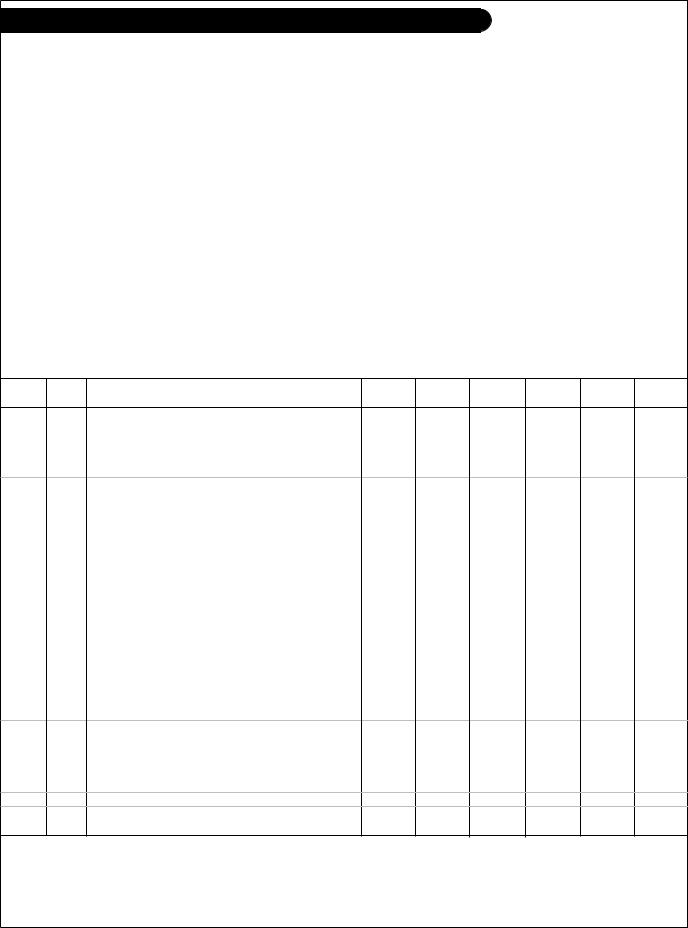
Service Schedule Chart, Mechanically Controlled Fuel System
The Servicing Schedule Chart below shows the service schedule required for proper maintenance of your marine generator set. More detailed coverage of each Service Point (SP) is listed on the page noted in the ‘page’ column.
DAILY:
SP1 Check oil level in engine
SP8 Check primary fuel filter
SP15 Check cooling water level
SP26 Check crankcase vent system filter svc. indicator button
AFTER FIRST 50 HOURS:
SP2 Change engine oil
SP3 Change lube oil filter
EVERY 50 HOURS:
SP21 Check electrolyte in batteries
FIRST 100 HOURS:
SP2 Change engine oil
SP3 Change lube oil filter
EVERY 100 HOURS:
SP13 Check turbocharger air, oil & cooling lines for leakage
EVERY 250 HOURS:
SP2 Change engine oil
SP3 Change lube oil filter
SP4 Check air cleaner
SP9 Change primary fuel filter element
SP13 Check turbocharger air, oil & cooling lines for leakage SP19 Check zinc electrodes
SP23 Test thermostats
AFTER FIRST 500 HOURS:
SP6 Check valve clearances
EVERY 500 HOURS / YEARLY:
SP4 Replace air cleaner SP5 Check belt condition
SP7 Check crankshaft vibration damper
SP10 Change secondary fuel filter
SP11 Check injectors
SP14 Check turbocharger boost pressure SP16 Check cooling system
SP20 Change impeller in raw water pump
SP22 Check the state of the charge of the batteries
SP26 Check crankcase vent system, change element at 750 hrs.
EVERY 2000 HOURS:
SP6 Check valve clearances, adjust if necessary SP12 Check fuel injection pump
SP17 Check and clean heat exchanger
SERVICE |
PAGE OPERATION |
dAILY |
50 |
100 |
250 |
500 |
2000 |
POINT |
Hours |
Hours |
Hours |
Hours |
Hours |
|
|
ENGINE: |
|
• |
|
|
|
|
SP1 |
15 |
Check oil level |
|
|
|
|
|
|
SP2 |
15 |
Change engine oil |
2) |
1) |
1) |
• |
|
|
SP3 |
15 |
Change lube oil filters |
2) |
1) |
1) |
• |
|
|
SP4 |
15 |
Check (replace) air cleaner |
2) 4) |
|
|
• |
• |
|
SP5 |
|
Check belt condition |
2) |
|
|
|
• |
|
SP6 |
16 |
Check valve clearances |
2) |
|
|
|
• |
• |
SP7 |
17 |
Check crankshaft vibration damper |
|
|
|
|
• |
|
|
|
FUEL SYSTEM: |
|
• |
|
|
|
|
SP8 |
17 |
Check primary filter (Racor) |
3) |
|
|
|
|
|
SP9 |
17 |
Change primary filter element (Racor) |
3) 4) |
|
|
• |
|
|
SP10 |
17 |
Change secondary fuel filter |
2) 4) |
|
|
|
• |
|
SP11 |
18-19 |
Check injectors |
2) |
|
|
|
• |
|
SP12 |
20-22 |
Check fuel injection pump |
|
|
|
|
|
• |
|
|
TURBOCHARGER: |
|
|
• |
|
|
|
SP13 |
23 |
Check air, oil & cooling water lines for leakage |
2) |
|
|
|
|
|
SP14 |
23 |
Check boost pressure |
|
|
|
|
• |
|
SP26 |
27 |
Check crankcase vent system |
|
• |
|
|
6) |
|
|
|
cooling system: |
|
• |
|
|
|
|
SP15 |
25 |
Check cooling water level |
|
|
|
|
|
|
SP16 |
25 |
Check and flush cooling system |
2) |
|
|
|
• |
5) |
SP17 |
25 |
Check and clean heat exchanger |
2) |
|
|
|
|
• |
SP19 |
25-26 |
Check zinc electrodes |
2) 4) |
|
|
• |
• |
|
SP20 |
26 |
Change impeller in raw water pump |
2) 4) |
|
|
|
|
|
|
|
ELECTRICAL SYSTEM: |
|
|
|
|
|
|
SP21 |
27 |
Check electrolyte level in batteries |
2) 4) |
• |
|
|
|
|
SP22 |
27 |
Check condition of batteries with hydrometer |
2) |
|
|
|
• |
|
SP23 |
|
Test thermostats |
|
|
|
• |
|
|
1) |
Change the oil and filter at 50 hours, using break-in oil again, until changing it |
4) |
Or whenever necessary. |
|
at 100 hours, then at every 250 hours. |
5) Check the cooling system at 500 hours, flush at 2000 hours. |
|
2) |
Perform all maintenance once a year even if hour level has not been reached. |
6) |
Check hoses and o-rings, replace element at 750 hours. |
3) |
Consult manufacturer's maintenance schedule. |
|
|
OM2-2 11/08
14
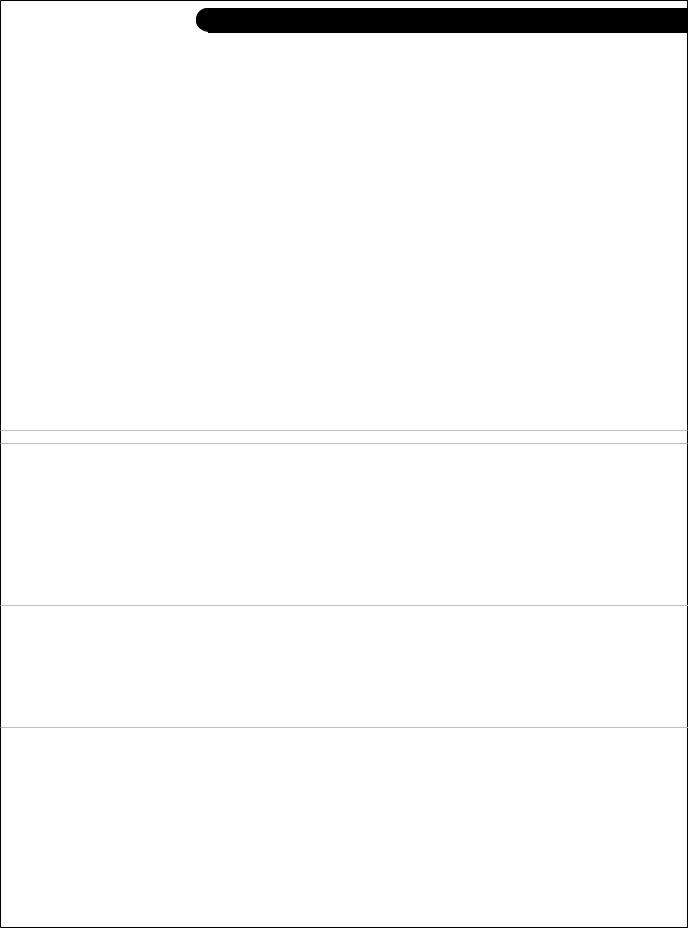
Service Schedule Chart, Electronically Controlled Fuel System
The Servicing Schedule Chart below shows the service schedule required for proper maintenance of your marine generator set. More detailed coverage of each Service Point (SP) is listed on the page noted in the ‘page’ column.
DAILY:
SP1 Check oil level in engine
SP8 Check primary fuel filter
SP15 Check cooling water level
SP26 Check crankcase vent system filter svc. indicator button
AFTER FIRST 50 HOURS:
SP2 Change engine oil
SP3 Change lube oil filter
EVERY 50 HOURS:
SP21 Check electrolyte in batteries
AFTER FIRST 100 HOURS/ EVERY TWO WEEKS 5:
SP2 Change engine oil after first 100 hrs., then check every 2 wks. SP3 Change oil filter after first 100 hrs., then check every 2 wks.
SP7 Check crankshaft vibration damper7 SP15 Check coolant level
EVERY 250 HOURS :
SP2 Change engine oil
SP3 Change lube oil filter
SP4 Check air cleaner SP19 Check zincs
EVERY 500 HOURS / YEARLY:
SP4 Replace air cleaner SP5 Check belt condition
SP9 Change primary filter element (Racor) SP10 Change secondary fuel filter
SP11 Check injectors
SP14 Check turbocharger boost pressure SP16 Check cooling system
SP20 Change impeller in raw water pump
SP22 Check the state of the charge of the batteries SP25 Check engine mounts
SP26 Check crankcase vent system, change element at 750 hrs. SP27 Check air intake hoses
SP29 Check electrical ground connection
EVERY 2000 HOURS:
SP6 Check & adjust valve clearance SP7 Check crankshaft vibration damper SP12 Check fuel injection pump
SP16 Flush cooling system
SP17 Check and clean heat exchanger SP23 Test thermostats
SP30 Check aftercooler, clean air side
SERVICE |
|
|
|
|
50 |
100 |
250 |
500 |
2000 |
POINT |
PAGE |
OPERATION |
|
dAILY |
Hours |
Hours |
Hours |
Hours |
Hours |
|
|
ENGINE: |
|
• |
|
|
|
|
|
SP1 |
15 |
Check oil level |
|
|
|
• |
|
|
|
SP2 |
15 |
Change engine oil |
2) |
|
1) |
1) |
|
|
|
SP3 |
15 |
Change lube oil filters |
2) |
|
1) |
1) |
• |
|
|
SP4 |
15 |
Check air cleaner |
|
|
|
|
• |
• |
|
SP5 |
|
Check belt condition |
2) |
|
|
|
|
• |
|
SP6 |
16 |
Check valve clearances |
2) |
|
|
|
|
|
• |
SP7 |
17 |
Check crankshaft vibration damper |
5) |
|
|
|
|
|
• |
SP25 |
|
Check engine mounts |
|
|
|
|
|
• |
|
SP27 |
|
Check air intake hoses |
|
|
|
|
|
• |
|
|
|
FUEL SYSTEM: |
|
• |
|
|
|
|
|
SP8 |
17 |
Check primary filter (Racor) |
3) |
|
|
|
|
|
|
SP9 |
17 |
Change primary filter element (Racor) |
3) 4) |
|
|
|
|
• |
|
SP10 |
17 |
Change secondary fuel filter |
2) 4) |
|
|
|
|
• |
|
SP11 |
18-19 |
Check injectors |
|
|
|
|
|
|
6) |
SP12 |
20-22 |
Check fuel injection pump |
|
|
|
|
|
|
• |
|
|
TURBOCHARGER: |
|
|
|
• |
|
|
|
SP13 |
23 |
Check air, oil & cooling water lines for leakage |
2) |
|
|
|
|
|
|
SP14 |
23 |
Check boost pressure |
|
|
|
|
|
• |
|
SP30 |
27 |
Check aftercooler, clean air side |
|
|
|
|
|
|
• |
SP26 |
27 |
Check crankcase vent system |
|
• |
|
|
|
8) |
|
|
|
COOLING SYSTEM: |
|
• |
|
|
|
|
|
SP15 |
25 |
Check cooling water level |
|
|
|
|
|
|
|
SP16 |
25 |
Check and flush cooling system |
2) |
|
|
|
|
7) |
• |
SP17 |
25 |
Check and clean heat exchanger |
2) |
|
|
|
|
|
• |
SP19 |
25-26 |
Check zinc electrodes |
2) 4) |
|
|
|
• |
|
|
SP20 |
26 |
Change impeller in raw water pump |
2) 4) |
|
|
|
|
• |
|
|
|
ELECTRICAL SYSTEM: |
|
|
• |
|
|
|
|
SP21 |
27 |
Check electrolyte level in batteries |
2) 4) |
|
|
|
|
|
|
SP22 |
27 |
Check condition of batteries with hydrometer |
2) |
|
|
|
|
• |
|
SP23 |
|
Test thermostats |
|
|
|
|
|
|
• |
SP29 |
|
Check electrical ground connection |
|
|
|
|
|
• |
|
|
|
|
|
|
|
|
|
|
|
1)Change the oil and filter at 50 hours, using break-in oil again, until changing it at 100 hours, then at every 250 hours.
2)Perform all maintenance once a year even if hour level has not been reached.
3)Consult manufacturer's maintenance schedule.
4)Or whenever necessary.
5)Replace damper every 4500 hours or after 60 months.
6)Check at 5000 hours.
7)Check cooling system at 500 hours, flush at 2000 hours.
8)Check hoses, and o-rings on crankcase vent system, change element at 750 hours.
OM2-2 11/08
15
